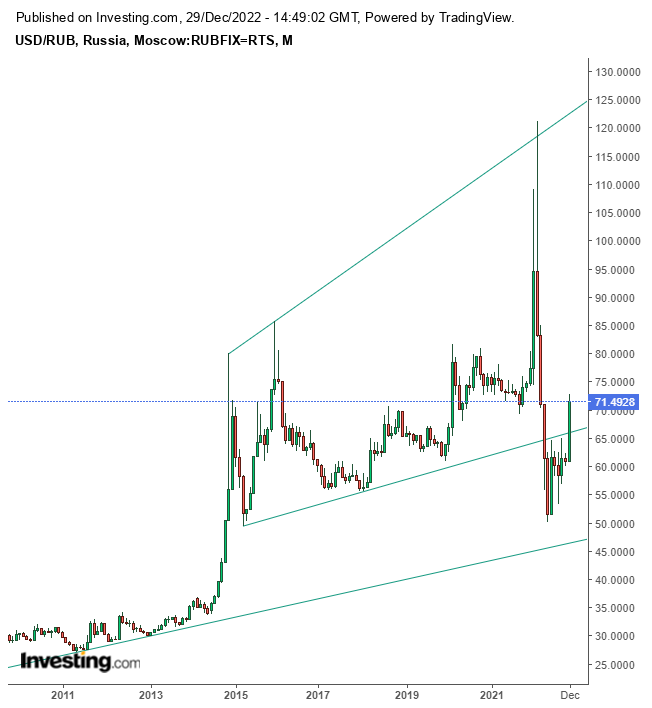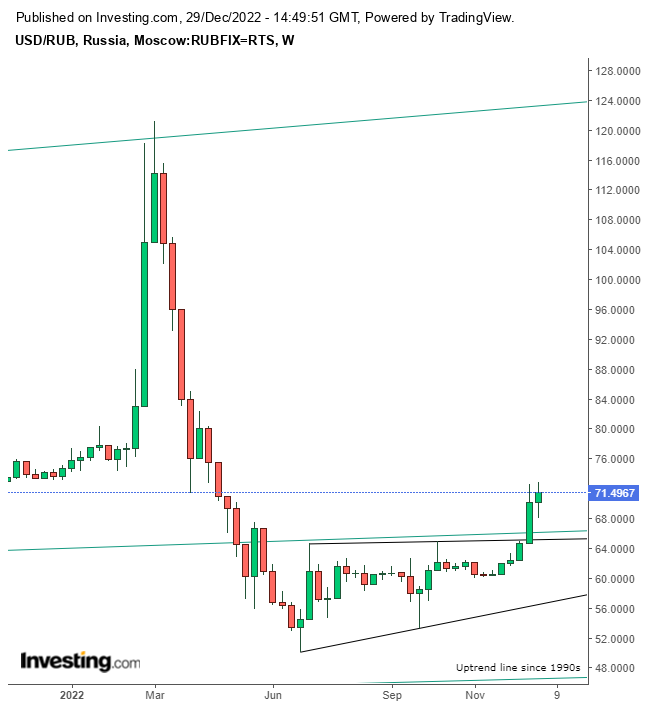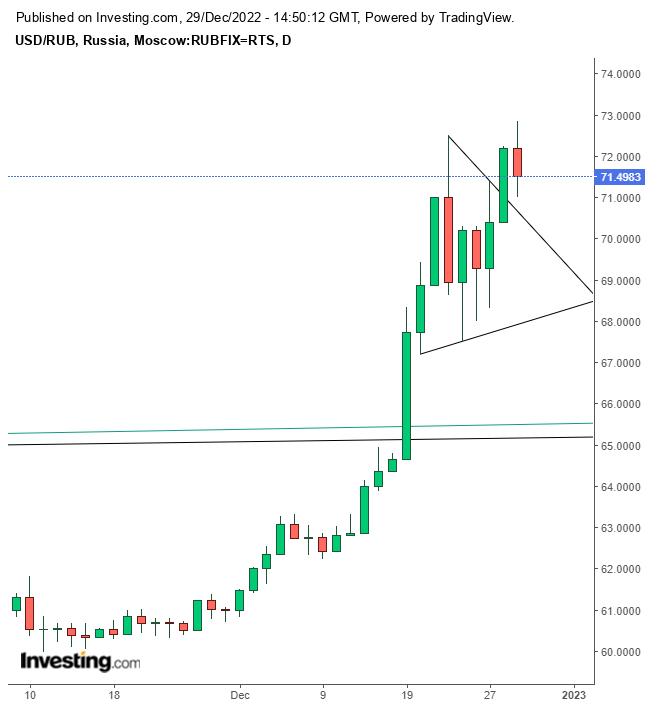Chart of the Day: Sanctions, Economic Challenges Impacting Russia
2022.12.29 14:06
[ad_1]
- Western sanctions, including oil price caps and a ban on purchasing Russian crude oil, are reducing Russian export income and potentially increasing the budget deficit
- The Russian ruble has fallen significantly against the dollar, leading to upward pressure on inflation and potentially requiring the Bank of Russia to reintroduce interest rate hikes
- These economic challenges, combined with falling energy revenues, are expected to result in a contraction in Russia’s economy in 2023 and strain on its balance sheets
- The dollar/ruble has broken into a rising channel since December 2014, suggesting that the previous dynamic strengthening the ruble is being reversed
- The dollar formed a triangular bottom versus the ruble, matching up almost perfectly with the range bottom since April 2015 and the long-term uptrend line since the 1990s
- The pair has completed a pennant, with a sharp rally that promises a repeat performance and a potential surge of 100,000 pips from the 71.0000 breakout point toward the 81.000 level
Western sanctions against Russia over its invasion of Ukraine significantly impact the country’s economy. Oil price caps and a ban on purchasing Russian by the G-7 countries, the European Union, and Australia are reducing Russian export income and potentially increasing the budget deficit. Price caps on Russia’s crude and refined oil exports could force the Kremlin to cut output by 5% and 7% next year.
The has also fallen significantly against the US dollar, leading to upward pressure on due to higher import costs. The may need to reintroduce interest rate hikes to keep inflation under control. These economic challenges, combined with falling energy revenues, are expected to lead to a contraction in Russia’s economy in 2023 and strain its balance sheets.
There is a risk that a significant external rebalancing will be needed in 2024, which will slow growth. The current account surplus, which has been a critical pillar of strength for the Russian economy this year, is expected to “shrink rapidly” in the coming months. According to officials, despite these challenges, Moscow should be able to finance any shortfalls through domestic bond issuance and its rainy day fund.
Technical Analysis

The dollar-ruble broke into a rising channel since Dec. 2014, suggesting that the previous dynamic strengthening the ruble to the strongest in seven years is being reversed. The rebound occurred after nearing its historical uptrend since the 1990s.
The Russian ruble has seen a significant increase in value between February and June due to high demand for the country’s energy exports, particularly oil and gas, which have contributed to economic growth.
Despite being under sanctions imposed by the EU and the US in response to Russia’s invasion of Ukraine, the EU, Russia’s primary customer for these energy sources, has continued to buy billions of dollars worth of Russian energy each week. Capital controls implemented by Russia’s central bank have also supported the ruble by reducing foreign currency purchases in the country.
However, on Sept. 16, 1992, George Soros proved that even an economically mighty country such as Great Britain couldn’t artificially support a currency in the long term. Are we witnessing Russia’s failure to do the same?

Here, we see that the dollar formed a triangular bottom versus the ruble, but what’s most significant about the range is that (1) it matches up almost perfectly with the range bottom since Apr. 2015 and (2) the long-term uptrend line since 1992.
The implied target based on the bottom’s height is 14.5 from the 65 breakout point, aiming for 79.5.

Finally, the pair completed a pennant yesterday, which is retesting today, so far, successfully.
The sharp rally that set up the give-and-take between buyers and sellers that make up the pennant promise a repeat performance, with 100,000 pips surge from the 71.0000 breakout point toward the 81.000 level.
Trading Strategies
Conservative traders should wait for the price to close above 72.5000, then retest the pennant’s support.
Moderate traders would be content with a successful show of support after piercing already the 72.5000 level on an intraday basis yesterday.
Aggressive traders can enter now, providing they accept the higher risk proportionate to the higher return of beating more cautious peers awaiting confirmation.
Trade Sample – Aggressive Long Position
- Entry: 71.0000
- Stop-Loss: 70.0000
- Risk:10,000 pips
- Target : 81.000
- Reward: 100,000 pips
- Risk-Reward Ratio: 1:10
[ad_2]








